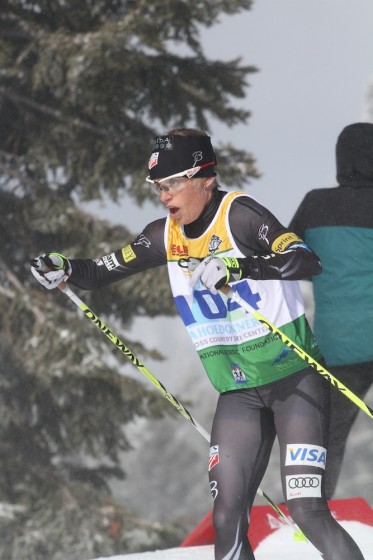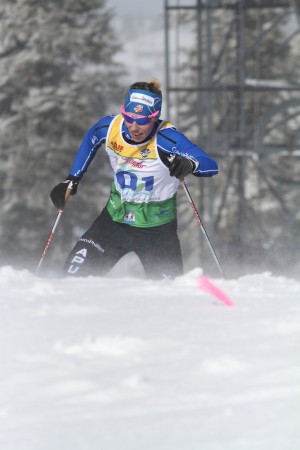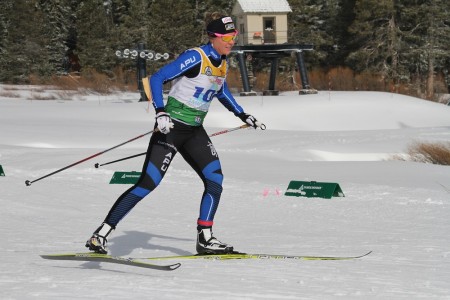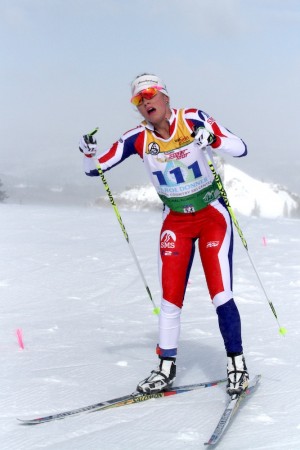
FasterSkier’s coverage of SuperTour Finals and U.S. Distance Nationals is brought to you by the generous support of Concept2, the leading manufacturer of indoor rowers, racing oars, and the SkiErg.
TRUCKEE, Calif. — It’s no secret that Liz Stephen (Burke Mountain Academy/U.S. Ski Team) has an affinity for skiing really hard climbs. Where other people struggle to wrap their minds around a race to the top of an alpine slope, the 26-year-old thrives in environments where she’s up against the mountain, the elements, and the pain and suffering they induce.
Stephen was second in the world in the final climb of the Tour de Ski this January; and has proven time and again that she is unrivaled when it comes to going up the precipitous pitches that most people prefer do go down.
For the ultimate stage of SuperTour Finals, a 6-kilometer freestyle hill climb at Sugar Bowl Resort, Stephen continued her impressive record and demolished the field by 1 minute, 44.9 seconds on time-of-day, with a finishing time of 27:57.7. The time gap, though considerable, is not really a surprise. After all, she won the Climb to the Castle rollerski race up Whiteface Mountain in September by five whole minutes.
What’s surprising, however, was that she was able to surpass Kikkan Randall (Alaska Pacific University/USST) from 2:26 down in doing so, snatching the overall SuperTour Finals title by 38.3 seconds. After three stages, the tour victory had looked to be in the bag for Randall. But Stephen was on her game Monday and, in what turned into a critical factor, Randall handicapped herself when she skied off the designated trail up one of the course’s steepest pitches, losing valuable time.
The win came as a surprise to Stephen, too.

“I honestly wasn’t expecting to catch Kikkan today,” Stephen said. “I was expecting to get close, but I thought that gap was going to be too big. But that just goes to show you go out and you try your hardest each day.”
With hill climbs, the terrain on which a race unfolds is as much an active player in the outcome as are the people competing. For this particular race, athletes were treated to the additional challenge of extreme weather — as if to say that climbing a mountain on skate skis wasn’t hard enough, Mother Nature provided a special mixture of treacherously strong winds on Monday morning. The higher the course went up Sugar Bowl’s blue runs, the more extreme the wind became.
“It was brutal,” Stephen said.
“Brutal. Miserable,” echoed Chelsea Holmes of the Sun Valley Ski Education Foundation, who had the third-fastest time.
Racers later spoke of having to adjust the angle of their pole plants so they could control where their baskets would land as the wind blew them sideways. The course was stripped down to the ice in some parts and piled up with dense drifts in others. Blowing snow pelted skiers’ exposed faces. A thousand feet above the starting line, the finish banner whipped threateningly in the wind. Nordic skiers are drawn to the sport for its singular difficulty, and the ingredients were all there for this hill climb to go down as one of the most memorable races of them all.
Knowing what waited for them, the women lined up ready for anything at the base of the mountain. The race began with a flat, rolling 3 k before the real incline began.
Randall left the start a full minute and nineteen seconds ahead of the next women, Sadie Bjornsen (APU/USST). Stephen didn’t set foot on the course until over a minute after that. But as soon as she did, the two women in front of her knew the clock would be running with Stephen hot on their tails.
“I knew Liz would be coming by, of course,” Bjornsen said. “I was kind of making bets with her for how far it would be until she caught me.”
The very first starter in the pursuit, Randall wasn’t fazed by being hunted down.
“I mean, it’s fun,” she said. “I always view these hill climbs as it’s me versus the mountain, really. So it was fun to be out front, fun to know I had a chance. I knew it’d be close and it was.”
The course brought skiers to the peak at 7,953 feet by way of two traverses across the face in between direct climbs up the slope. The flat first half of the race was merely a place to conserve energy and anticipate the impending suffer-fest.
Once the climb began, athletes had to dance a fine line between making forward progress and avoiding the redline. Stephen can accomplish this task at a higher threshold than anyone else on impossible grades, and she tracked down Bjornsen, the first target in front of her, on traverse number one. Focused on her own internal battle, Bjornsen processed Stephen moving past her and quickly returned her attention to moving her own two feet.

“It’s hard to look straight up the hill because that just makes it harder, so I watched her for a second when she went by me and then just put my head down,” Bjornsen said. “Just trying to keep a rhythm in my legs.”
Up ahead, Randall was still a ways in front of Stephen. As the minutes ticked by and the hill kept going up through a tunnel of howling wind, Stephen frequently reminded herself that things could be worse.
“I kept thinking [of when] I did this hill climb in Poland two years ago and it was like this day except no sun and we had no idea where we were going and it was like a whiteout and then you had to go down, also,” Stephen said. “The wind was coming at you the whole time, pushing you back downwards, and this was a least coming at the side of us or the back of us. So I kept thinking when it was getting really hard, ‘This could be worse this could be worse.’”
She also kept her eyes on Randall, who was drawing ever closer. She watched as her friend and teammate made a critical error at a turn in the course and start going up the wrong way. Instead of staying inside the quickly-eroding blue borders that marked the course, Randall followed her line of sight up the more direct but incorrect route. By the time she realized her mistake and turned around to go the right way, she likely lost around half a minute.
The way Randall described it later, the mistake was the product of being too exhausted in the moment to realize what was happening.
“I saw a gate ahead of me and thought that’s where I needed to go,” she said. “I remember crossing the blue line but it didn’t occur to me that I shouldn’t be crossing the blue line… All a sudden I heard my name yelled out behind me and I was like, ‘Wow, everyone’s getting really excited cheering all of a sudden.’”
When spectators kept yelling at Randall after she’d passed them, she knew something was wrong. She looked back and saw former APU skier James Southam running up to her, indicating she had to go back.
“I saw the gate and I went, ‘Ahhhh…’” Randall said.
So back down she went. On the correct course once more, Randall still had a few more turns to make before the top, and behind her, Stephen was getting ever closer. The race leader didn’t let herself think about the time she cost herself with the wrong turn, as it would have been counterproductive to the race yet to be skied.
“At that point I was still focused on making it up that pitch,” Randall said. “My legs were really starting to tie up and I just focused on making steps forward.”
There’s no telling how much of a difference that time made. Stephen closed in on Randall as they crested the top of the last big hill before they meandered along the ridge to the finish line. By the time they came within sight of the timing building, Stephen was well ahead of Randall and crossed the finish line 30:23.7 after the gun had gone off down below for a time-of-day mark of 27:57.7. But even after she’d passed her, Stephen didn’t quite count Randall out.
“I looked back like three times because I was sure she was going to just outsprint me,” Stephen said.
Instead, Randall looked tired as she double-poled across the finish. In the base lodge much later, she admitted the wrong turn and resulting loss was a bummer.
“In the end with it being a little bit close, I could have used that extra 20 or 30 seconds,” she said.
For Stephen, to end SuperTour Finals by winning it was simply an added bonus to a week that wasn’t geared towards results.
“I didn’t have expectations this week at all,” she said. “I just wanted to come out and enjoy myself and I’ve totally done that, and I’m psyched to have won today. It’s so fun to end the season on a podium, for sure, but honestly the goal was to go out, have fun, go as hard as I can up that hill. And I happened to bring home a win today.”
Bjornsen held on to her position and was third across the line, 1:35 behind Stephen. As a skier not traditionally suited towards climbing or skating, she was thrilled to hang on to a podium finish.
“I’m definitely happy,” she said. “Deep down my goal was to finish still standing on the podium, but I didn’t know if that was realistic.”
Sweden’s Maria Graefnings (Falun Borlange SK), who started fourth, held off a charging Jessie Diggins (SMST2/USST) to finish in the same position, crossing the line 3:12.6 behind Stephen. Climbing is not usually her strong suit, so she was happy to both hang on and to wrap up the tour in good standing against a strong U.S. field.
“It’s super competitive; it’s such a good field here,” Graefnings said. “It’s good motivation for next season to see I can kind of keep up with those girls, ’cause they all had a really good season, so I’m happy.”

Embedded within the pursuit-style climb was an individual race, too. Stephen had the fastest time-of-day by far, but it was Diggins who followed her with the next best time, much to her own surprise. Diggins started 10th, four minutes behind Randall, and clambered past five other people to finish fifth in the tour, seven seconds behind Graefnings.
Diggins caught and passed Annelies Cook (Maine Winter Sports Center/USBA) and Susan Dunklee (Craftsbury Green Racing Project/USBA) on the early flats and later skied with Rosie Brennan (APU) on the climb.
After the sprint on Saturday, Diggins had considered herself “physically and mentally done.” But with the help of some pink-and-purple race-day makeup, she amped herself up for another competition and was happy to learn that she was still ready to go for the final stage.
“I was really quite burned out, so I had to go to some drastic measures to get myself excited today, including some lipstick and glitter and colors on my face,” she said. “It’s nice to be like, ‘OK, just get in the mindset one more time, you can do this.”
It was a mantra she likely repeated to herself as she worked toward the top of the mountain with her poles blowing sideways.
“It was definitely a real test kind of a day, a mental-stubbornness test,” Diggins said.
Twenty-four seconds behind Diggins on time-of-day, Holmes was third fastest and 12th overall. She was pleased with the result, though she admitted to not being totally prepared for the difficulty of the course.
“I was so not prepared, mentally,” Holmes said. “I was like, ‘Oh, it’s not as hard as Jay Peak’ (site of the hill climb in 2012). And then I was going up it and was like, ‘I am so dumb. I am so wrong’… It was tough.”
Though the women still have a 30 k classic mass start to complete, Monday’s hill climb was the last SuperTour race of the season. There were double SuperTour points available at the Finals, and overall points leaders on the men’s and women’s lists will be going back to the World Cup in the fall. Brennan was the points leader going into the Finals and she still is now that the season is over. She finished sixth overall in the mini-tour, 10 seconds behind Diggins, with the seventh-fastest time of day.
“More than anything I was hoping to keep the SuperTour lead, and I think I’ve done that now so that’s really nice,” Brennan said.
If FasterSkier’s calculations are correct, Brennan ends the season with 582 SuperTour points to Bjornsen’s 399 points.
Results: hill climb | SuperTour Finals.
For more photos, head to MacBeth Graphics’ gallery.
— Alex Matthews contributed reporting.
Audrey Mangan
Audrey Mangan (@audreymangan) is an Associate Editor at FasterSkier and lives in Colorado. She learned to love skiing at home in Western New York.




4 comments
John Forrest Tomlinson
April 9, 2013 at 5:34 am
Ouch that looks hard.
I can’t help but think Stephen (and other small people) could use a few safety pins on each side of their bibs so they catch less wind.
highstream
April 9, 2013 at 3:33 pm
What’s the point of the hill climb – and with only one to two days rest before the 30k/50k races? They don’t even do that on the WC.
mr.gayasaids
April 9, 2013 at 6:25 pm
Nice snatch, Liz.
Pingback: realizar pagina web